ElasticSearch聚合
前言
说完了ES的索引与检索,接着再介绍一个ES高级功能API – 聚合(Aggregations),聚合功能为ES注入了统计分析的血统,使用户在面对大数据提取统计指标时变得游刃有余。同样的工作,你在Hadoop中可能需要写mapreduce或Hive,在mongo中你必须得用大段的mapreduce脚本,而在ES中仅仅调用一个API就能实现了。
开始之前,提醒老司机们注意,ES原有的聚合功能Facets在新版本中将被正式被移除,抓紧时间用Aggregations替换Facets吧。Facets真的很慢!
1 关于Aggregations
Aggregations的部分特性类似于SQL语言中的group by,avg,sum等函数。但Aggregations API还提供了更加复杂的统计分析接口。
掌握Aggregations需要理解两个概念:
- 桶(Buckets):符合条件的文档的集合,相当于SQL中的group by。比如,在users表中,按“地区”聚合,一个人将被分到北京桶或上海桶或其他桶里;按“性别”聚合,一个人将被分到男桶或女桶
- 指标(Metrics):基于Buckets的基础上进行统计分析,相当于SQL中的count,avg,sum等。比如,按“地区”聚合,计算每个地区的人数,平均年龄等
对照一条SQL来加深我们的理解:
SELECT COUNT(color) FROM table GROUP BY color
GROUP BY相当于做分桶的工作,COUNT是统计指标。
下面介绍一些常用的Aggregations API。
2 Metrics
2.1 AVG
2.2 Cardinality
2.3 Stats
2.4 Extended Stats
2.5 Percentiles
2.6 Percentile Ranks
3 Bucket
3.1 Filter
3.2 Range
3.3 Missing
3.4 Terms
3.5 Date Range
3.6 Global Aggregation
3.7 Histogram
3.8 Date Histogram
3.9 IPv4 range
3.10 Return only aggregation results
4 聚合缓存
ES中经常使用到的聚合结果集可以被缓存起来,以便更快速的系统响应。这些缓存的结果集和你掠过缓存直接查询的结果是一样的。因为,第一次聚合的条件与结果缓存起来后,ES会判断你后续使用的聚合条件,如果聚合条件不变,并且检索的数据块未增更新,ES会自动返回缓存的结果。
注意聚合结果的缓存只针对size=0的请求(参考3.10章节),还有在聚合请求中使用了动态参数的比如Date Range中的now(参考3.5章节),ES同样不会缓存结果,因为聚合条件是动态的,即使缓存了结果也没用了。
先加入几条index数据,如下:
curl -XPUT 'localhost:9200/testindex/orders/2?pretty' -d '{ "zone_id": "1", "user_id": "100008", "try_deliver_times": 102, "trade_status": "TRADE_FINISHED", "trade_no": "xiaomi.21142736250938334726", "trade_currency": "CNY", "total_fee": 100, "status": "paid", "sdk_user_id": "69272363", "sdk": "xiaomi", "price": 1, "platform": "android", "paid_channel": "unknown", "paid_at": 1427370289, "market": "unknown", "location": "local", "last_try_deliver_at": 1427856948, "is_guest": 0, "id": "fa6044d2fddb15681ea2637335f3ae6b7f8e76fef53bd805108a032cb3eb54cd", "goods_name": "一小堆元宝", "goods_id": "ID_001", "goods_count": "1", "expires_in": 2592000, "delivered_at": 0, "debug_mode": true, "created_at": 1427362509, "cp_result": "exception encountered", "cp_order_id": "cp.order.id.test", "client_id": "9c98152c6b42c7cb3f41b53f18a0d868", "app_user_id": "fvu100006" }'
1、单值聚合
Sum求和,dsl参考如下:
[sfapp@cmos1 ekfile]$ curl 'http://10.202.11.117:9200/testindex/orders/_search?pretty' -d ' > { > "size": 0, > "aggs": { > "return_expires_in": { > "sum": { > "field": "expires_in" > } > } > } > }' { "took" : 3, "timed_out" : false, "_shards" : { "total" : 5, "successful" : 5, "failed" : 0 }, "hits" : { "total" : 2, "max_score" : 0.0, "hits" : [ ] }, "aggregations" : { "return_expires_in" : { "value" : 5184000.0 } } } [sfapp@cmos1 ekfile]$
返回expires_in之和,其中size=0 表示不需要返回参与查询的文档。
Min求最小值
[sfapp@cmos1 ekfile]$ curl 'http://10.202.11.117:9200/testindex/orders/_search?pretty' -d ' > { > "size": 0, > "aggs": { > "return_min_expires_in": { > "min": { > "field": "expires_in" > } > } > } > }' { "took" : 3, "timed_out" : false, "_shards" : { "total" : 5, "successful" : 5, "failed" : 0 }, "hits" : { "total" : 2, "max_score" : 0.0, "hits" : [ ] }, "aggregations" : { "return_min_expires_in" : { "value" : 2592000.0 } } } [sfapp@cmos1 ekfile]$
Max求最大值
[sfapp@cmos1 ekfile]$ curl 'http://10.202.11.117:9200/testindex/orders/_search?pretty' -d ' > { > "size": 0, > "aggs": { > "return_max_expires_in": { > "max": { > "field": "expires_in" > } > } > } > }' { "took" : 3, "timed_out" : false, "_shards" : { "total" : 5, "successful" : 5, "failed" : 0 }, "hits" : { "total" : 2, "max_score" : 0.0, "hits" : [ ] }, "aggregations" : { "return_max_expires_in" : { "value" : 2592000.0 } } } [sfapp@cmos1 ekfile]$
AVG求平均值
[sfapp@cmos1 ekfile]$ curl 'http://10.202.11.117:9200/testindex/orders/_search?pretty' -d ' > { > "size": 0, > "aggs": { > "return_avg_expires_in": { > "avg": { > "field": "expires_in" > } > } > } > }' { "took" : 4, "timed_out" : false, "_shards" : { "total" : 5, "successful" : 5, "failed" : 0 }, "hits" : { "total" : 2, "max_score" : 0.0, "hits" : [ ] }, "aggregations" : { "return_avg_expires_in" : { "value" : 2592000.0 } } } [sfapp@cmos1 ekfile]$
Cardinality 求基数(如下示例,查找性别的基数 M、F,共两个)
{
"size": 0,
"aggs": {
"return_cardinality": {
"cardinality": {
"field": "gender"
}
}
}
}
结果为:
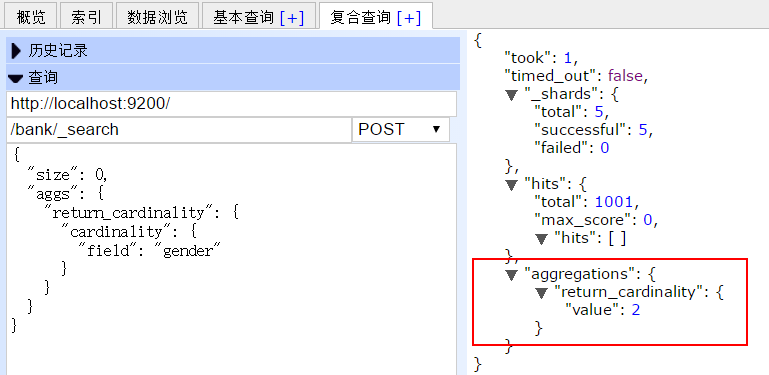
2、多值聚合
percentiles 求百分比
查看官方文档时候,没看懂,下面是自己测试时的例子,按照性别(F,M)查看工资范围的百分比
{
"size": 0,
"aggs": {
"states": {
"terms": {
"field": "gender"
},
"aggs": {
"banlances": {
"percentile_ranks": {
"field": "balance",
"values": [
20000,
40000
]
}
}
}
}
}
结果:
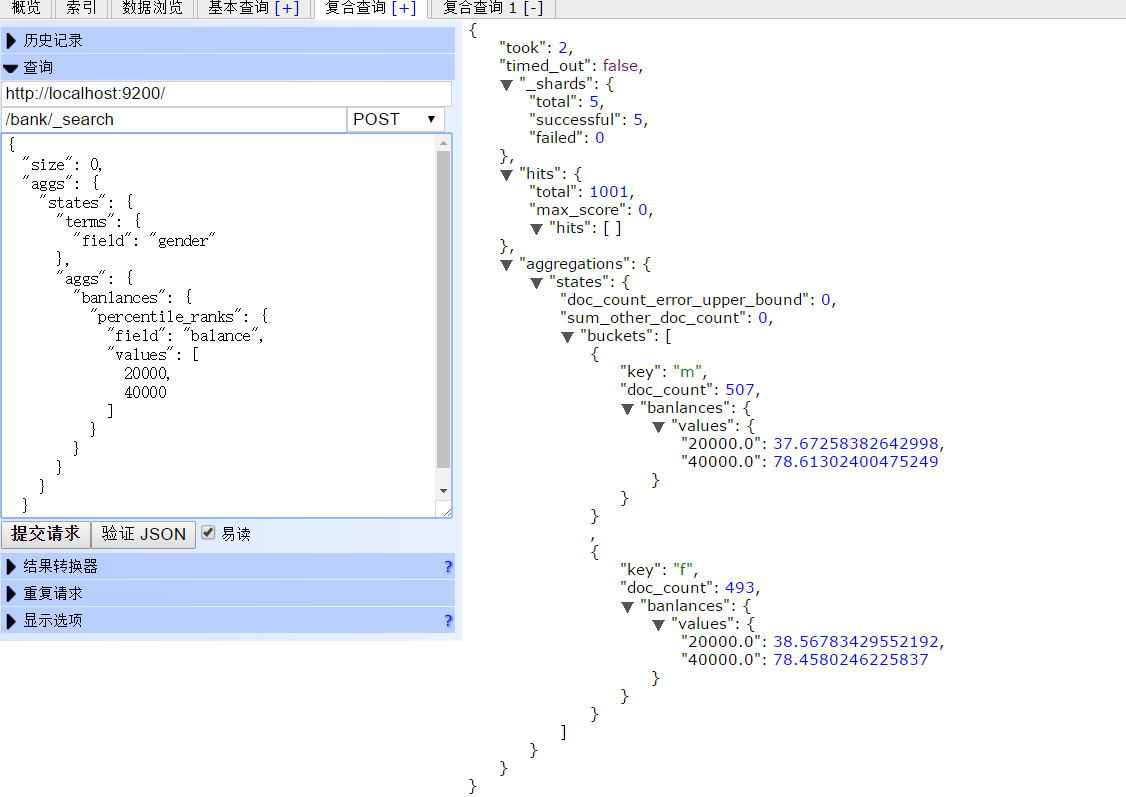
stats 统计
查看balance的统计情况:
{
"size": 0,
"aggs": {
"balance_stats": {
"stats": {
"field": "balance"
}
}
}
}
返回结果:
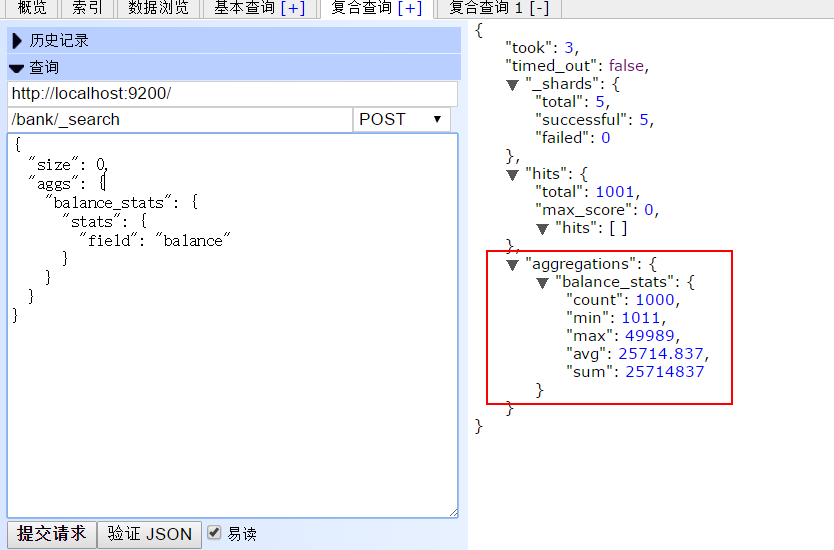
extended_stats 扩展统计
{
"size": 0,
"aggs": {
"balance_stats": {
"extended_stats": {
"field": "balance"
}
}
}
}
结果:

更加复杂的查询,后续慢慢在实践中道来。
Terms聚合
记录有多少F,多少M
{
"size": 0,
"aggs": {
"genders": {
"terms": {
"field": "gender"
}
}
}
}
返回结果如下:m记录507条,f记录493条
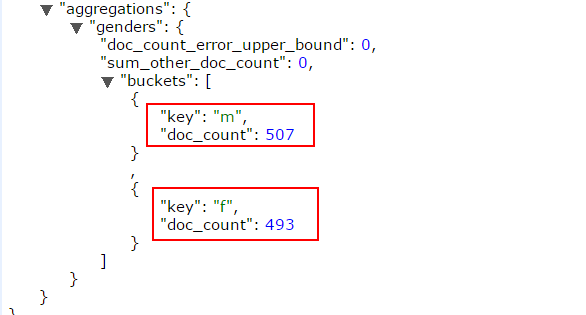
数据的不确定性
使用terms聚合,结果可能带有一定的偏差与错误性。
比如:
我们想要获取name字段中出现频率最高的前5个。
此时,客户端向ES发送聚合请求,主节点接收到请求后,会向每个独立的分片发送该请求。
分片独立的计算自己分片上的前5个name,然后返回。当所有的分片结果都返回后,在主节点进行结果的合并,再求出频率最高的前5个,返回给客户端。
这样就会造成一定的误差,比如最后返回的前5个中,有一个叫A的,有50个文档;B有49。 但是由于每个分片独立的保存信息,信息的分布也是不确定的。 有可能第一个分片中B的信息有2个,但是没有排到前5,所以没有在最后合并的结果中出现。 这就导致B的总数少计算了2,本来可能排到第一位,却排到了A的后面。
size与shard_size
为了改善上面的问题,就可以使用size和shard_size参数。
- size参数规定了最后返回的term个数(默认是10个)
- shard_size参数规定了每个分片上返回的个数
- 如果shard_size小于size,那么分片也会按照size指定的个数计算
通过这两个参数,如果我们想要返回前5个,size=5;shard_size可以设置大于5,这样每个分片返回的词条信息就会增多,相应的误差几率也会减小。
order排序
order指定了最后返回结果的排序方式,默认是按照doc_count排序。
{
"aggs" : {
"genders" : {
"terms" : {
"field" : "gender",
"order" : { "_count" : "asc" }
}
}
}
}
也可以按照字典方式排序:
{
"aggs" : {
"genders" : {
"terms" : {
"field" : "gender",
"order" : { "_term" : "asc" }
}
}
}
}
当然也可以通过order指定一个单值聚合,来排序。
{
"aggs" : {
"genders" : {
"terms" : {
"field" : "gender",
"order" : { "avg_balance" : "desc" }
},
"aggs" : {
"avg_balance" : { "avg" : { "field" : "balance" } }
}
}
}
}
同时也支持多值聚合,不过要指定使用的多值字段:
{
"aggs" : {
"genders" : {
"terms" : {
"field" : "gender",
"order" : { "balance_stats.avg" : "desc" }
},
"aggs" : {
"balance_stats" : { "stats" : { "field" : "balance" } }
}
}
}
}
返回结果:
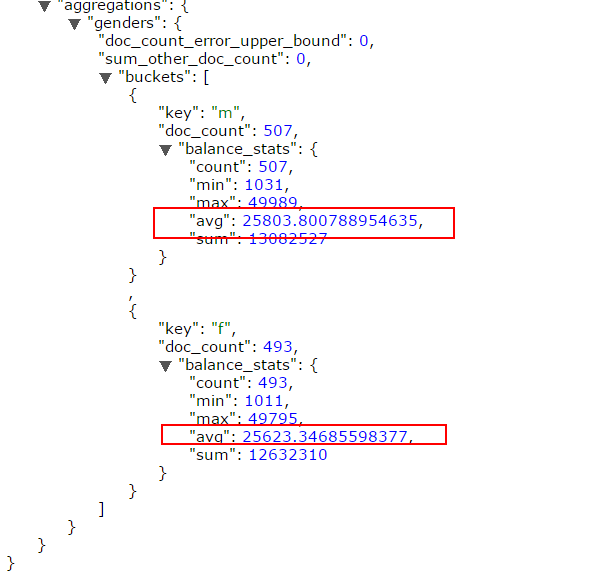
min_doc_count与shard_min_doc_count
聚合的字段可能存在一些频率很低的词条,如果这些词条数目比例很大,那么就会造成很多不必要的计算。
因此可以通过设置min_doc_count和shard_min_doc_count来规定最小的文档数目,只有满足这个参数要求的个数的词条才会被记录返回。
通过名字就可以看出:
- min_doc_count:规定了最终结果的筛选
- shard_min_doc_count:规定了分片中计算返回时的筛选
script
桶聚合也支持脚本的使用:
{
"aggs" : {
"genders" : {
"terms" : {
"script" : "doc['gender'].value"
}
}
}
}
以及外部脚本文件:
{
"aggs" : {
"genders" : {
"terms" : {
"script" : {
"file": "my_script",
"params": {
"field": "gender"
}
}
}
}
}
}
filter
filter字段提供了过滤的功能,使用两种方式:include可以匹配出包含该值的文档,exclude则排除包含该值的文档。
例如:
{
"aggs" : {
"tags" : {
"terms" : {
"field" : "tags",
"include" : ".*sport.*",
"exclude" : "water_.*"
}
}
}
}上面的例子中,最后的结果应该包含sport并且不包含water。
也支持数组的方式,定义包含与排除的信息:
{
"aggs" : {
"JapaneseCars" : {
"terms" : {
"field" : "make",
"include" : ["mazda", "honda"]
}
},
"ActiveCarManufacturers" : {
"terms" : {
"field" : "make",
"exclude" : ["rover", "jensen"]
}
}
}
}多字段聚合
通常情况,terms聚合都是仅针对于一个字段的聚合。因为该聚合是需要把词条放入一个哈希表中,如果多个字段就会造成n^2的内存消耗。
不过,对于多字段,ES也提供了下面两种方式:
- 1 使用脚本合并字段
- 2 使用copy_to方法,合并两个字段,创建出一个新的字段,对新字段执行单个字段的聚合。
collect模式
对于子聚合的计算,有两种方式:
- depth_first 直接进行子聚合的计算
- breadth_first 先计算出当前聚合的结果,针对这个结果在对子聚合进行计算。
默认情况下ES会使用深度优先,不过可以手动设置成广度优先,比如:
{
"aggs" : {
"actors" : {
"terms" : {
"field" : "actors",
"size" : 10,
"collect_mode" : "breadth_first"
},
"aggs" : {
"costars" : {
"terms" : {
"field" : "actors",
"size" : 5
}
}
}
}
}
}缺省值Missing value
缺省值指定了缺省的字段的处理方式:
{
"aggs" : {
"tags" : {
"terms" : {
"field" : "tags",
"missing": "N/A"
}
}
}
}